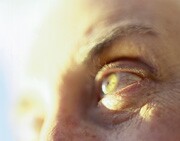
THURSDAY, May 29, 2014 (HealthDay News) — The dreaded drooping eyelids that often come with age are more likely to appear on men, people with fair skin and those who are overweight, a new study finds.
The study also suggests that sagging eyelids can run in families, and researchers have found at least one gene that may play a role in causing eyelid sag.
There’s no clear evidence that any of the risk factors directly cause sagging eyelids, and the researchers say these findings don’t offer an easy fix for droopy lids.
“Unfortunately, we cannot treat genes yet. But we can inform patients about risk factors like obesity, smoking and sun exposure, which they are able to modify themselves,” said study author Dr. Leonie Jacobs, a dermatology resident at Erasmus Medical Center in Rotterdam, the Netherlands.
Sagging eyelids occur when gravity causes eyelid skin to sag, sometimes even covering up the eyelashes.
“Due to aging, the connective tissue in the skin will change. The collagen and elastin fibers are reduced in number and functionality. Therefore the skin loses its strength and elasticity,” Jacobs said. “Typically, this process starts from the age of 40 and worsens with increasing age, but in some rare cases it starts in young adulthood.”
In one part of the new study, researchers looked at the eyelids of more than 5,500 white Dutch people. Their average age was 67. Eighteen percent showed moderate or severe eyelid sagging, with higher risk for men, smokers, those with lighter skin color (the kind that rarely tans) and those with extra pounds.
Severe eyelid sagging is linked to problems like blocked vision and headaches from trying to keep your eyes open wide enough to see more clearly.
In another part of the study, researchers looked at eyelid sagging in a British study of more than 2,100 twins with an average age of 53. About 90 percent were female. Of the twins, 15 percent showed signs of sagging eyelids.
The researchers found a genetic trait that seems to be related to the problem. They estimated that inherited factors account for 61 percent of the risk of sagging eyelids, with the rest of the risk influenced by factors such as age, gender and lifestyle.
“One is at a much higher risk when his or her close relatives are affected,” Jacobs said.
Dr. Michael Migliori, chief of the division of ophthalmology at Rhode Island Hospital, said the study won’t change any practices for plastic surgeons or dermatologists.
“I don’t think this paper adds much except to suggest that genetic studies might help identify who is likely to get saggy lids, although you can probably do that much more easily by looking at pictures of their parents,” Migliori said.
So, what can you do to prevent sagging eyelids? Maintain a healthy weight, don’t smoke and protect your skin from the sun.
“Lighter skin color is a risk factor. We did not prove that this is because of the higher susceptibility to UV-induced damage in light skin, although this is a known mechanism in skin aging,” Jacobs said. Therefore, I would also advise protecting your eyes and skin from the sun by wearing sunglasses or a hat with a brim.”
Surgery is an option, but blepharoplasty — the most common procedure to fix sagging eyelids — can cost between $2,000 and $5,000, Migliori said.
The study appears online May 28 in the journal JAMA Dermatology.
More information
Try the Mayo Clinic for more on plastic surgery to fix drooping eyelids.
Copyright © 2025 HealthDay. All rights reserved.

